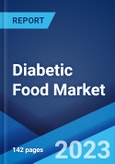Diabetic foods are dietary products that have low carbohydrate and sugar content and assist in controlling glucose levels in the blood. Diabetes is a disease characterized by high blood sugar levels resulting from insufficient insulin or a lack of cell response to the insulin produced by the body. Apart from this, diabetes also damages various other body parts such as the brain, nerves, eyes, kidneys and feet. Food products such as whole grains, brown rice, quinoa, oatmeal, millet and baked sweet potato are considered as healthy foods for people who have diabetes. These products can be consumed by the non-diabetic population as well, as a precautionary measure to prevent the occurrence of the disease in the future.
The increasing diabetic population across the globe coupled with the rising awareness of various health issues associated with diabetes are the key factors driving the growth of the market. Furthermore, increasing prevalence of obesity and diabetes owing to a lack of physical activity among children and adolescents is also contributing to the market growth. Consumers are increasingly becoming aware of the preventive measures that can be taken against diabetes. Additionally, growing research and development (R&D) to produce diabetic food products and a diversified product portfolio that caters to the requirements of a wide consumer base is further catalyzing the market growth. Moreover, owing to rapid digitalization and thriving e-commerce industry, manufacturers and vendors are adopting online retail systems to provide a broad product range to the consumers. This, along with the proliferation of supermarkets and hypermarkets, increasing geriatric population, and rising disposable income, contributes significantly to the market growth.
Key Market Segmentation:
The publisher provides an analysis of the key trends in each sub-segment of the global diabetic food market report, along with forecasts at the global and regional level from 2023-2028. The report has categorized the market based on product type, end consumers and distribution channel.Breakup by Product Type:
- Bakery Products
- Dairy Products
- Confectionery Products
- Beverages
- Snacks
- Spreads
- Others
Breakup by End Consumers:
- Children
- Adults
Breakup by Distribution Channel:
- Supermarkets and Hypermarkets
- Drug Stores/Pharmacies
- Grocery Stores
- Online Stores
- Others
Breakup by Region:
- Europe
- North America
- Asia Pacific
- Middle East and Africa
- Latin America
Competitive Landscape:
The report has also analysed the competitive landscape of the market along with the profiles of the key players.The publisher's latest report provides a deep insight into the global diabetic food market covering all its essential aspects. This ranges from macro overview of the market to micro details of the industry performance, recent trends, key market drivers and challenges, SWOT analysis, Porter’s five forces analysis, value chain analysis, etc. This report is a must-read for entrepreneurs, investors, researchers, consultants, business strategists, and all those who have any kind of stake or are planning to foray into the diabetic food market in any manner.
Key Questions Answered in This Report:
- How has the global diabetic food market performed so far and how will it perform in the coming years?
- What are the key regional markets in the global diabetic food industry?
- What has been the impact of COVID-19 on the global diabetic food industry?
- What is the breakup of the market based on the product type?
- What is the breakup of the market based on the end consumers?
- What is the breakup of the market based on the distribution channel?
- What are the various stages in the value chain of the global diabetic food industry?
- What are the key driving factors and challenges in the global diabetic food industry?
- What is the structure of the global diabetic food industry and who are the key players?
- What is the degree of competition in the global diabetic food industry?
- What are the profit margins in the diabetic food industry?
Table of Contents
Methodology

LOADING...
Table Information
| Report Attribute | Details |
|---|---|
| No. of Pages | 142 |
| Published | September 2023 |
| Forecast Period | 2022 - 2028 |
| Estimated Market Value ( USD | $ 11.2 Billion |
| Forecasted Market Value ( USD | $ 17.5 Billion |
| Compound Annual Growth Rate | 7.7% |
| Regions Covered | Global |









